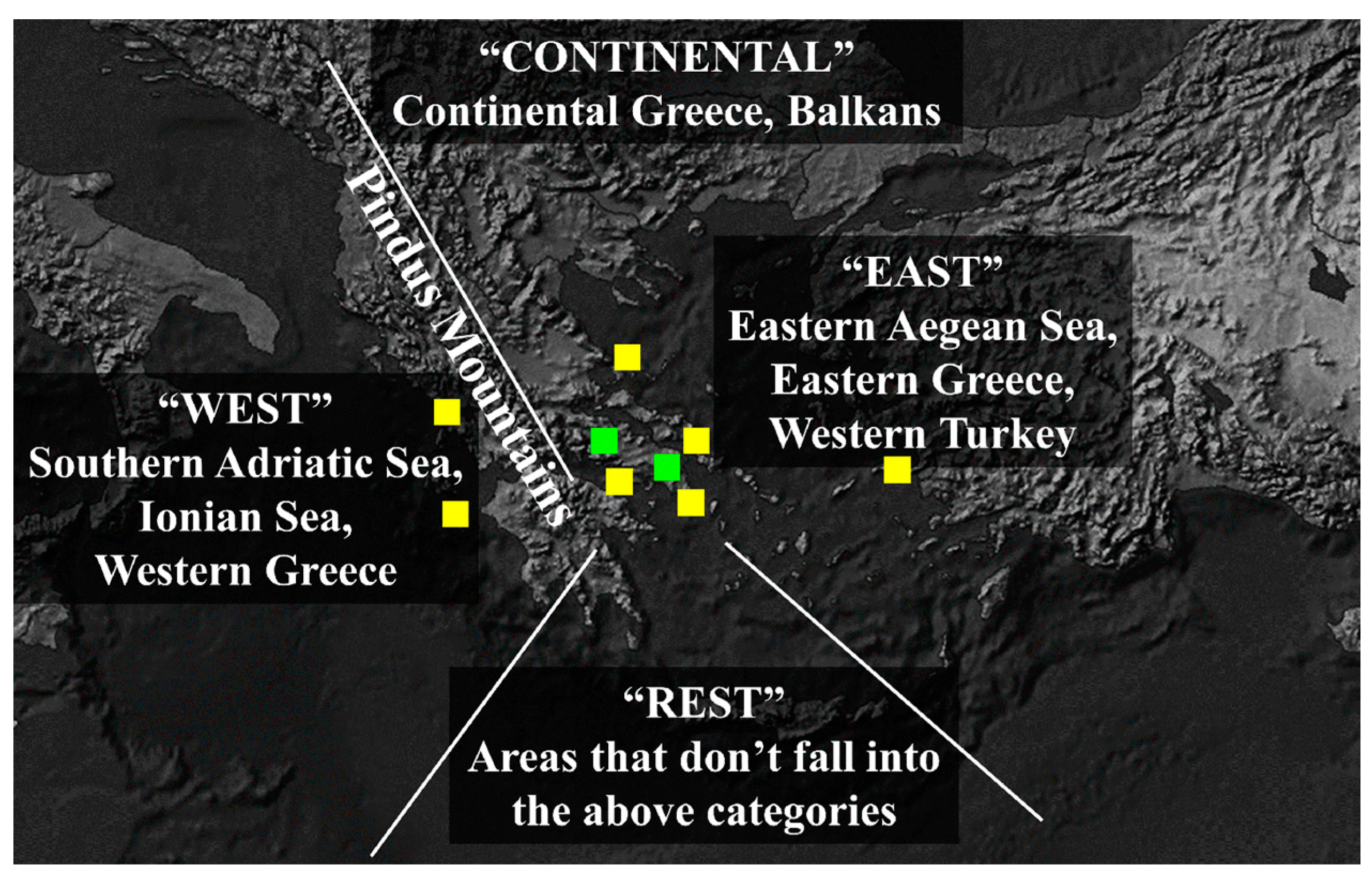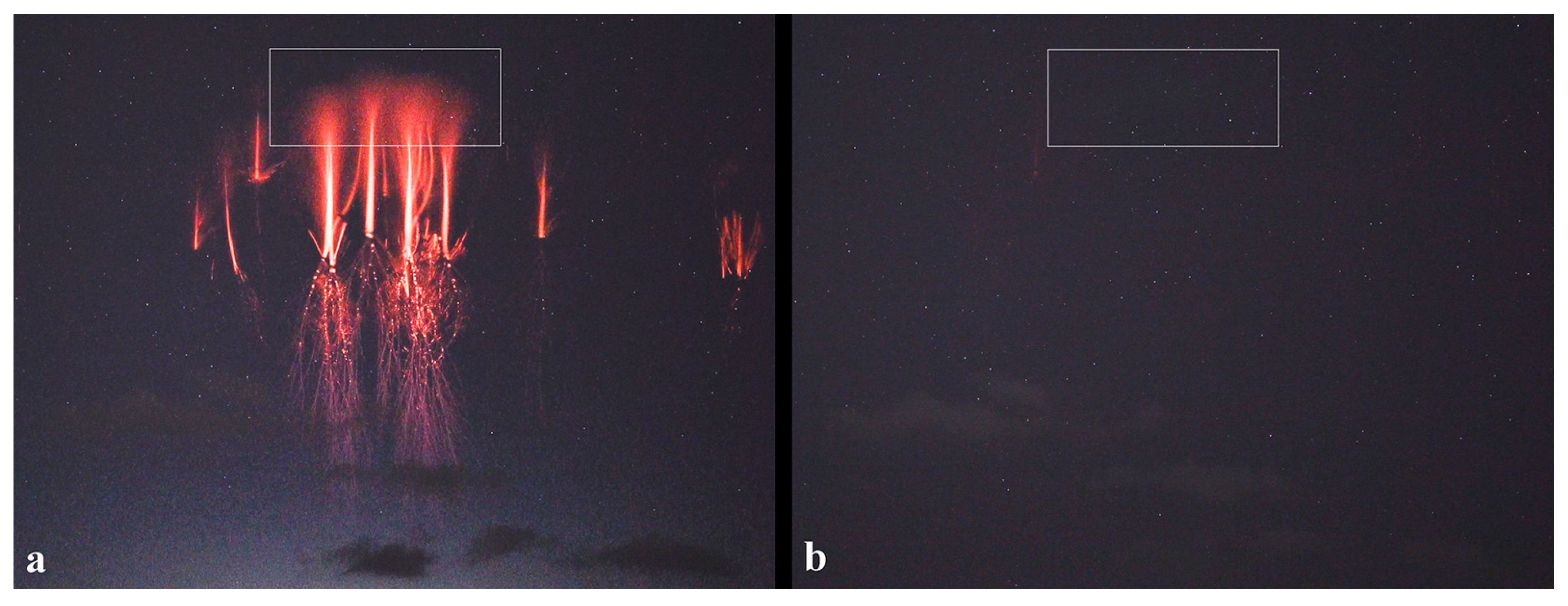Observations of Transient Luminous Events from Greece †
Abstract
:1. Introduction
2. Materials and Methods
3. Results
4. Discussion
Supplementary Materials
Author Contributions
Funding
Institutional Review Board Statement
Informed Consent Statement
Data Availability Statement
Conflicts of Interest
References
- Pasko, V.P.; Inan, U.S.; Bell, T.F.; Taranenko, Y.N. Sprites produced by quasi-electrostatic heating and ionization in the lower ionosphere. J. Geophys. Res. 1997, 102, 4529–4561. [Google Scholar] [CrossRef]
- Fukunishi, H.; Takahashi, Y.; Kubota, M.; Sakanoi, K.; Inan, U.S.; Lyons, W.A. Elves: Lightning-induced transient luminous events in the lower ionosphere. Geophys. Res. Lett. 1996, 23, 2157–2160. [Google Scholar] [CrossRef]
- Barrington-Leigh, C.P.; Inan, U.S.; Stanley, M. Identification of sprites and elves with intensified video and broadband array photometry. J. Geophys. Res. 2001, 106, 1741–1750. [Google Scholar] [CrossRef]
- Pasko, V.P.; Stanley, M.A.; Mathews, J.D.; Inan, U.S.; Wood, T.G. Electrical discharge from a thundercloud top to the lower ionosphere. Nature 2002, 416, 152–154. [Google Scholar] [CrossRef]
- Wescott, E.M.; Sentman, D.D.; Heavner, M.J.; Hampton, D.L.; Vaughan, O.H. Blue Jets: Their relationship to lightning and very large hailfall, and their physical mechanisms for their production. J. Atmos. Sol. Terr. Phys. 1998, 60, 713–724. [Google Scholar] [CrossRef]
- Liu, N.; Pasko, V.P.; Frey, H.U.; Mende, S.B.; Su, H.-T.; Chen, A.B.; Hsu, R.-R.; Lee, L.-C. Assessment of sprite initiating electric fields and quenching altitude of a1Πg state of N2 using sprite streamer modeling and ISUAL spectrophotometric measurements. J. Geophys. Res. 2009, 114, A00E02. [Google Scholar] [CrossRef]
- Gordillo-Vázquez, F.J.; Passas, M.; Luque, A.; Sánchez, J.; van der Velde, O.A.; Montanyà, J. High spectral resolution spectroscopy of sprites: A natural probe of the mesosphere. J. Geophys. Res. Atmos. 2018, 123, 2336–2346. [Google Scholar] [CrossRef]
- Li, J.; Cummer, S.; Lu, G.; Zigoneanu, L. Charge moment change and lightning-driven electric fields associated with negative sprites and halos. J. Geophys. Res. 2012, 117, A09310. [Google Scholar] [CrossRef]
- Gordillo-Vázquez, F.J.; Luque, A.; Simek, M. Spectrum of sprite halos. J. Geophys. Res. 2011, 116, A09319. [Google Scholar] [CrossRef]
- Stenbaek-Nielsen, H.; Ashcraft, T.; McHarg, M.; Harley, J. Analysis and modeling of sprite green ghosts. In Proceedings of the AGU 2020 Fall Meeting, Online, 1–17 December 2020. [Google Scholar] [CrossRef]
- Chen, A.B.; Kuo, C.-L.; Lee, Y.-J.; Su, H.-T.; Hsu, R.-R.; Chern, J.-L.; Frey, H.U.; Mende, S.B.; Takahashi, Y.; Fukunishi, H.; et al. Global distributions and occurrence rates of transient luminous events. J. Geophys. Res. 2008, 113, A08306. [Google Scholar] [CrossRef]









Disclaimer/Publisher’s Note: The statements, opinions and data contained in all publications are solely those of the individual author(s) and contributor(s) and not of MDPI and/or the editor(s). MDPI and/or the editor(s) disclaim responsibility for any injury to people or property resulting from any ideas, methods, instructions or products referred to in the content. |
© 2023 by the authors. Licensee MDPI, Basel, Switzerland. This article is an open access article distributed under the terms and conditions of the Creative Commons Attribution (CC BY) license (https://creativecommons.org/licenses/by/4.0/).
Share and Cite
Doudoulakis, C.; Papathanasiou, T.; Sagiakos, D.; Tsouras, P. Observations of Transient Luminous Events from Greece. Environ. Sci. Proc. 2023, 26, 9. https://doi.org/10.3390/environsciproc2023026009
Doudoulakis C, Papathanasiou T, Sagiakos D, Tsouras P. Observations of Transient Luminous Events from Greece. Environmental Sciences Proceedings. 2023; 26(1):9. https://doi.org/10.3390/environsciproc2023026009
Chicago/Turabian StyleDoudoulakis, Christos, Thanasis Papathanasiou, Dimitris Sagiakos, and Panagiotis Tsouras. 2023. "Observations of Transient Luminous Events from Greece" Environmental Sciences Proceedings 26, no. 1: 9. https://doi.org/10.3390/environsciproc2023026009
APA StyleDoudoulakis, C., Papathanasiou, T., Sagiakos, D., & Tsouras, P. (2023). Observations of Transient Luminous Events from Greece. Environmental Sciences Proceedings, 26(1), 9. https://doi.org/10.3390/environsciproc2023026009




